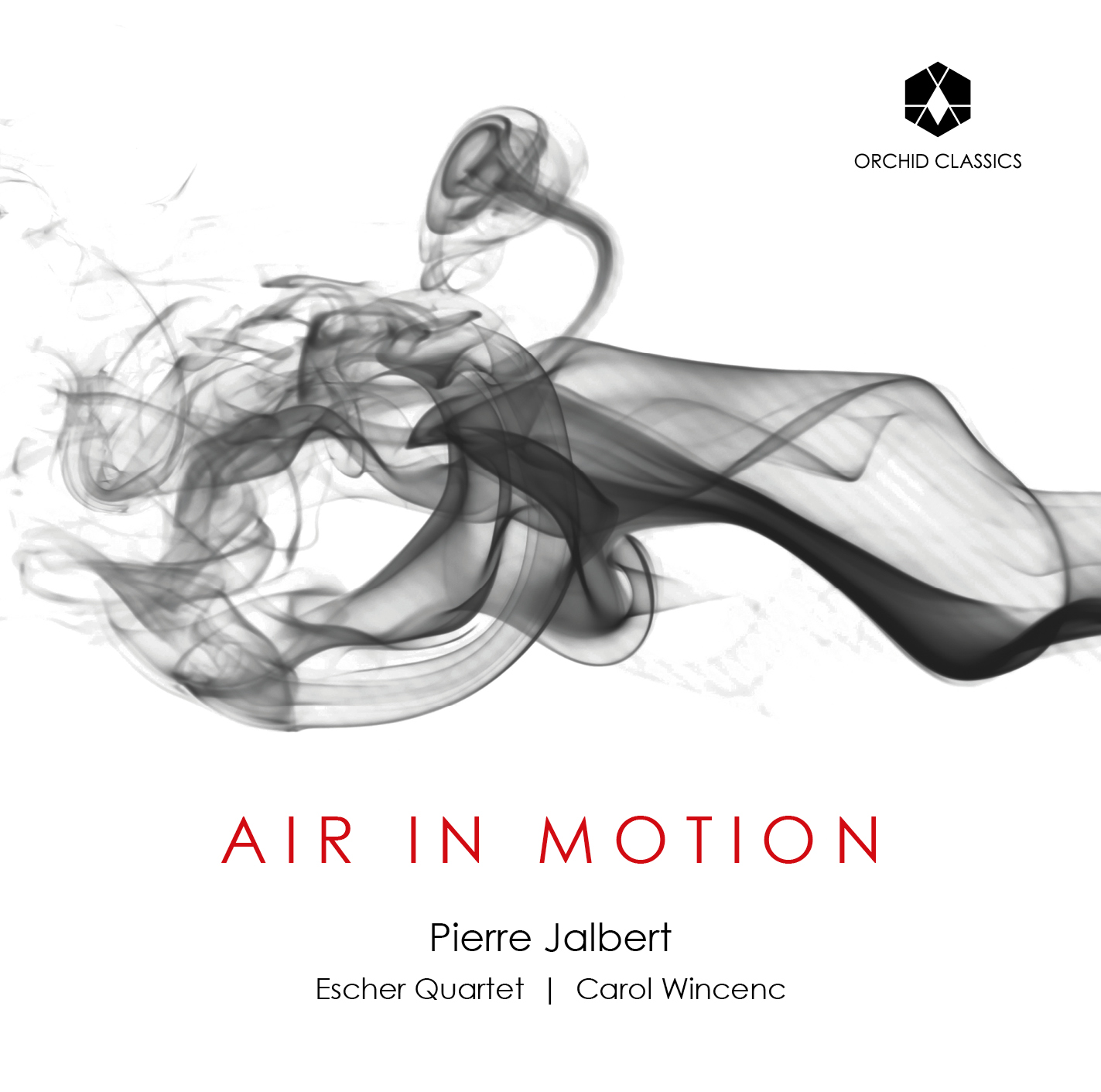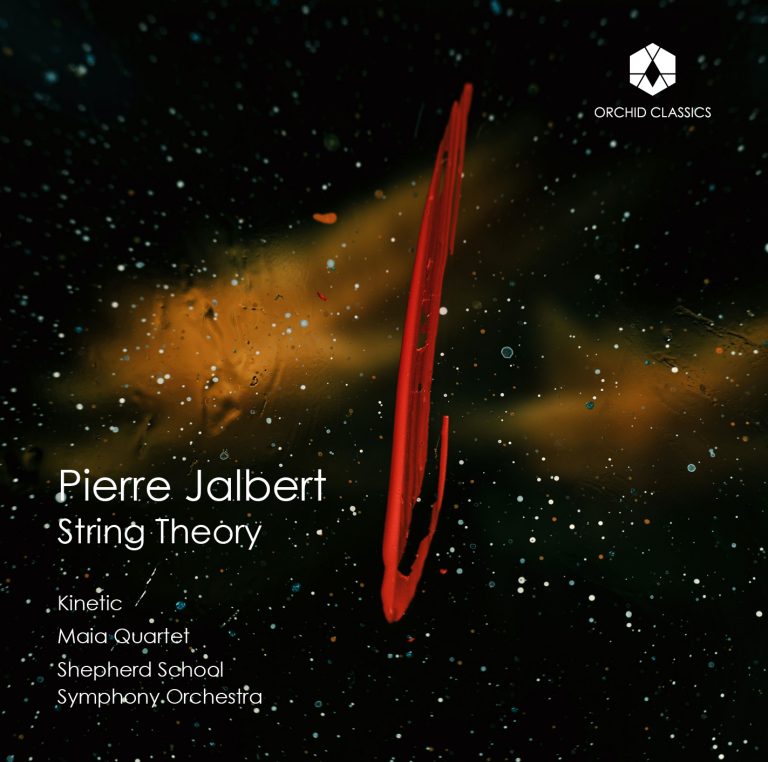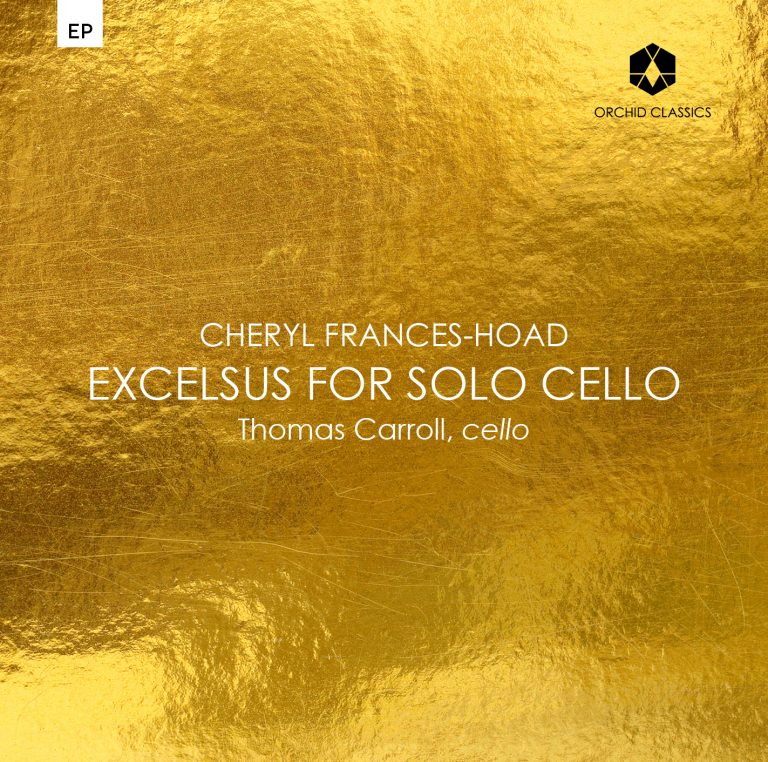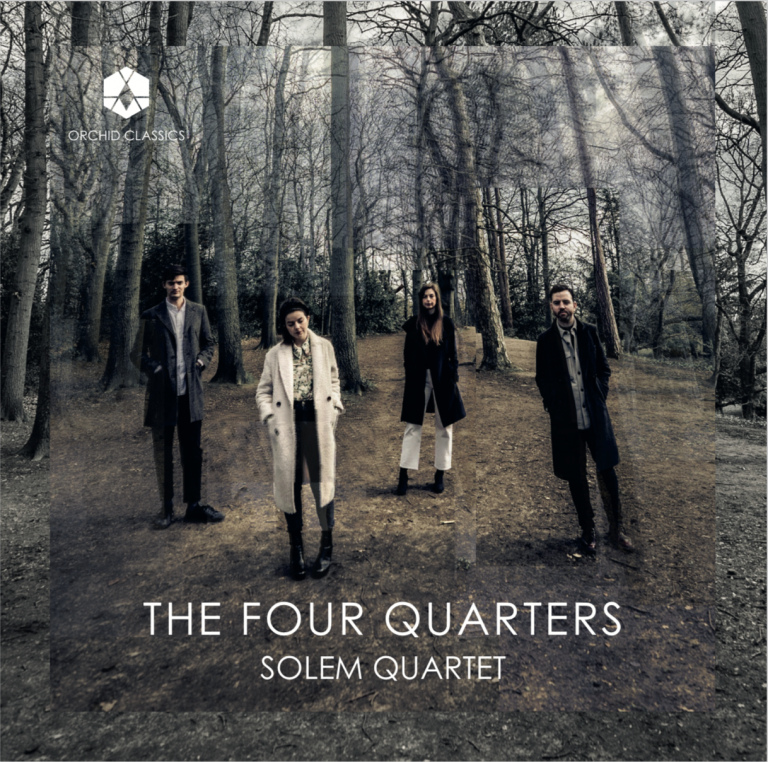Artist Led, Creatively Driven

Air in Motion
Pierre Jalbert
Escher Quartet
Carol Wincenc, flute
Release Date: September 23rd
ORC100203
AIR IN MOTION
Pierre Jalbert (b.1967)
String Quartet No.4
1 I Spiral I
2 II Waveform
3 III Labyrinth
4 IV Spiral II
Air in Motion
5 I Turning
6 II Canon on 50 notes
7 III Air
8 IV Pushing the Envelope
String Quartet No.6 (“Canticle”)
9 I Eternal, timeless
10 II Intense, dramatic
11 III Scherzando
12 IV Ethereal
13 V Driving
14 VI Still
15 VII Soulful, mysterious
Escher String Quartet:
Adam Barnett-Hart, violin
Brendan Speltz, violin
Pierre Lapointe, viola
Brook Speltz, cello
Carol Wincenc, flute
This recording celebrates my long and fruitful relationship with the Escher Quartet, and also salutes the beloved flutist Carol Wincenc on her 50th Anniversary season. Though the string ensemble is the common thread in all of these recorded works, their inspiration and ideas are quite varied. In String Quartet No.4, dynamic shapes and configurations – spiral, waveform, labyrinth – are the catalysts for each movement, whereas String Quartet No.6 (“Canticle”) invokes the idea of ritual as its point of departure – coloured by the use of small, bell-like disks called crotales. Air in Motion brings a flute into the ensemble, adding a new dimension suggested by the flow of air through a column of metal.
String Quartet No.4 (2008)
I Spiral I
II Waveform
III Labyrinth
IV Spiral II
My fourth string quartet was commissioned by the Caramoor International Festival, on behalf of the Escher String Quartet, for the festival’s String Quartet Library for the 21st Century. The dynamic shapes that inspired the piece informed its musical gestures and contours. The opening, Spiral I, functions as a short prelude, and presents materials that will be further developed in the last movement. The idea of spirals – descending lines curving back upon themselves, and lines curving outwards from a central point – are constant throughout the first movement. The work’s slow movement, Waveform, opens quietly, and gradually builds to a resonant climax, beginning and ending with its wave-like sound, a quarter-tone oscillation centred on the note D. All of the instruments are muted in the scherzo-like Labyrinth, which is a study in quickly shifting accents with a middle section featuring delicately plucked strings. The finale, Spiral II, is in constant motion, with syncopated accents, full of rhythmic energy and intensity, as it develops and extends material from the opening movement.
Air in Motion for flute and string quartet (2019)
I Turning
II Canon on 50 notes
III Air
IV Pushing the Envelope
Air in Motion was commissioned for and inspired by Carol Wincenc, in celebration of her 50th Anniversary season. The title refers to the flute’s ability to generate beauty from the simple aspect of air flowing through the instrument. Carol has dedicated a great deal of her career to commissioning and presenting new works, thus the title of the final movement of the work, “Pushing the Envelope.” We all owe her a debt of gratitude for her commitment to living composers.
The work, in four contrasting movements, opens with a short, fast, rhythmic prelude with strings and flute echoing each other’s changing rhythmic pulse (like mini “metric modulations” that turn on a dime). The second movement is a canon on 50 notes (honouring Carol’s anniversary), and begins as a repeating, ascending pattern that gradually changes over time, reappearing later in slow motion and in different guises throughout the piece. The almost chant-like third movement is an air, with slowly evolving resonances in “frozen” time. The pulse-oriented finale features rhythmic and imitative motives passed between strings and flute, with slower interruptive events that always lead back to the rhythmic energy of the opening.
String Quartet No.6 (“Canticle”) (2017)
I Eternal, timeless
II Intense, dramatic
III Scherzando
IV Ethereal
V Driving
VI Still
VII Soulful, mysterious
String Quartet No.6 (“Canticle”) contains seven movements, highly contrasting in character, with movements I and VII serving as bookends to the overall arch of the work. Bell sounds, created by the striking of crotales, ultimately blend with the strings, evoking the work’s title. In the faster, rhythmically driven music, the musicians use glass rods on their instruments, and at one point the music quickly moves back and forth between alternating rhythmic sub-divisions (“metric modulations”). The ensemble blends with bowed crotales in the finale, bringing the work to an ethereal, other-worldly conclusion.
Pierre Jalbert
Pierre Jalbert
American composer Pierre Jalbert has earned widespread attention for his richly coloured and superbly crafted scores which paint vibrant sonic portraits for the listener through a musical language that is engaging, expressive, and “immediately captures one’s attention with its strong gesture and vitality” (American Academy of Arts and Letters). Drawing inspiration from a variety of sources from plainchant melodies to natural phenomena and his French-Canadian heritage, his music has been commissioned and performed worldwide by artists and institutions including the Boston Symphony, London Symphony, the Los Angeles and St. Paul Chamber Orchestras, the Symphonies of Houston, Cincinnati, Budapest, Vermont, Albany, and Milwaukee, the National Symphony, and the Cabrillo and Eastern Festival Orchestras among others. Hailed as an “acknowledged chamber-music master” by The New Yorker, his chamber music has been commissioned and performed by Midori, the Chamber Music Society of Lincoln Center, the Escher, Emerson, Ying, Del Sol, Chiara, and Borromeo String Quartets, Music from Copland House, Morgenstern Trio, Arizona Friends of Chamber Music, Chatter, and the Pittsburgh New Music Ensemble.
Known for his “rhapsodic and skilfully written” (The New York Times) music, his discography features recordings by David Finckel and Wu Han, his Violin Concerto with the Los Angeles Chamber Orchestra and Margaret Batjer as soloist, Kinetic, the Jupiter, Pro Arte and Ying Quartets, and the Music from Copland House ensemble.
Among his many honours are the Rome Prize, the BBC Masterprize, a Guggenheim Fellowship, the Fromm Foundation commission, the Chamber Music Society of Lincoln Center’s Stoeger Award, given biennially “in recognition of significant contributions to the chamber music repertory”, and an Academy award from the American Academy of Arts and Letters. Jalbert has served as Composer-in-Residence with the Los Angeles Chamber Orchestra, California Symphony under Barry Jekowsky, and Chicago’s Music in the Loft. He is Professor of Composition at Rice University’s Shepherd School of Music in Houston, and his music is published by Schott Music.
Escher String Quartet
The Escher String Quartet has received acclaim for its profound musical insight and rare tonal beauty. A former BBC New Generation Artist and recipient of the Avery Fisher Career Grant, the quartet has performed at the BBC Proms at Cadogan Hall and is a regular guest at Wigmore Hall. In its hometown of New York, the ensemble serves as season artists of the Chamber Music Society of Lincoln Center.
Recordings of the complete Mendelssohn quartets and beloved romantic quartets of Dvorak, Borodin and Tchaikovsky were released on the BIS label in 2015-18 and received critical acclaim, with comments such as “…eloquent, full-blooded playing… The four players offer a beautiful blend of individuality and accord” (BBC Music Magazine). In 2019, Dance, an album of quintets with Grammy award winning guitarist Jason Vieaux, was enthusiastically received. The Escher’s most recent recording, the complete quartets of Charles Ives and Samuel Barber, was met with equal excitement, including “A fascinating snapshot of American quartets, with a recording that is brilliantly detailed, this is a first-rate release all around” (Strad Magazine). The ensemble has also recorded the complete Zemlinsky String Quartets in two volumes, released on the Naxos label in 2013 and 2014.
The Escher Quartet has held faculty positions at Southern Methodist University in Dallas, Texas and the University of Akron, Ohio and takes its name from the Dutch graphic artist M.C. Escher.
Carol Wincenc
Flute
Called “Queen of the Flute” by New York magazine, Carol Wincenc delights audiences with her charismatic presence, high virtuosity, and heartfelt musicality. Beginning her illustrious career as the sole Grand Prize flute winner of the renowned Naumburg Competition, she has concertized on five continents, and loves nothing more than “giving back” to communities worldwide. Beloved as concerto soloist, Grammy Award-winning recording artist, devoted chamber music performer, and professor-mentor to now luminaries in the flute world, she has also been the muse for our era’s legendary composers.
Carol’s remarkable career has elevated the status of the flute as a solo instrument through the extraordinary range of her performances with world-renowned ensembles and fellow soloists, awards, commissioning of over 50 new works in multiple genres written by leading composers and teaching countless students who have followed in her footsteps.
She has appeared as soloist with major orchestras worldwide, including the Chicago, San Francisco, Pittsburgh, Detroit, and London symphonies, the BBC, Warsaw, and Buffalo Philharmonics, as well as the Los Angeles, Stuttgart, and Saint Paul Chamber Orchestras. In great demand as a chamber musician, Ms. Wincenc has collaborated with such celebrated ensembles as the Emerson, Tokyo, Guarneri, Cleveland, Juilliard, and Escher String Quartets, and performed with Jessye Norman, Emanuel Ax and Yo-Yo Ma. She has enjoyed residencies and performances at countless festivals, including Mostly Mozart, Aldeburgh, Budapest, Frankfurt, Santa Fe, Spoleto, Music at Menlo, Aspen, Yale/Norfolk, Sarasota, Banff, and Marlboro. She is a current member of the New York Woodwind Quintet and a founding member of Les Amies with New York Philharmonic Principals, harpist Nancy Allen and violist Cynthia Phelps. Her newest, exciting collaboration, Duo Coquelicot, is with renowned Boston based cellist, Velleda Miragias.










